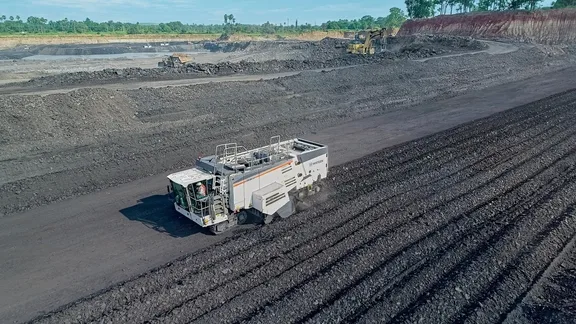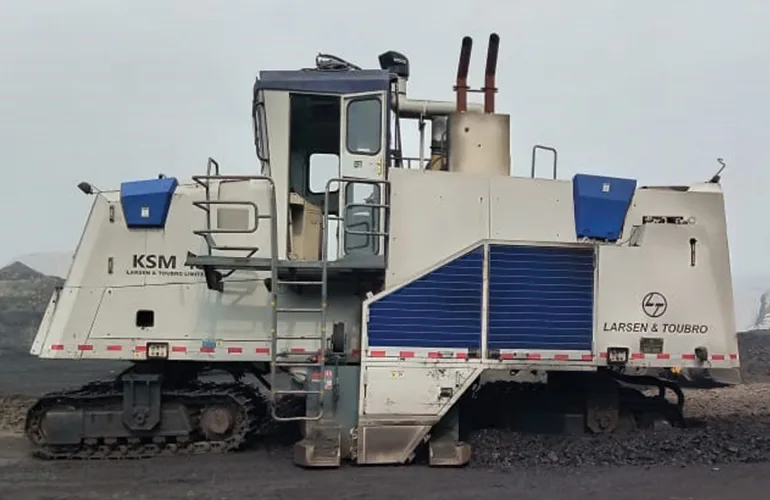A surface miner is a specialized heavy machinery used for excavation and extraction of materials from the soil. Its primary function is to remove overburden or non-valuable substances from the ground, thereby providing access to valuable resources and establishing a solid foundation for construction projects. Unlike conventional excavation techniques such as drilling and blasting, which involve breaking rock or soil using explosives, surface miners employ cutting, grinding, or milling tools to directly extract material from the surface. They find applications in various fields, including open-pit mining, quarrying for minerals and aggregates, road construction, and other projects requiring controlled and efficient surface material removal.
How does surface miner work?
A surface miner works with several key components to efficiently excavate and process materials from the earth’s surface. Here’s an overview of its main components and how they work together:
- Cutting Tool/ Drum: The surface miners contain a series of cutting tools/drum, typically made of tungsten carbide or other durable materials. These cutting tools rotate on a horizontal axis and come into contact with the surface material.
- Power Source: Surface miners are powered by engines, which can be diesel or electric. The power source provides the energy needed to drive the cutting drum and other machine functions.
- Operator’s Cabin: An operator’s cabin is usually positioned on top of the machine, providing the operator with a clear view of the work area.
- Conveyor System: Located behind the cutting drum, a conveyor system collects the material that has been excavated by the cutting tools. This conveyor system transports the material away from the cutting area for further processing or loading onto trucks.
- Track or Wheel System: Surface miners are often mounted on tracks or wheels to allow mobility across the construction site. This mobility enables the machine to move to different work areas efficiently.
An overview of how components work together:
- Activation: The operator starts the surface miner’s engine and engages the cutting drum.
- Cutting Process: As the cutting drum rotates, the cutting tools come into contact with the surface material, whether it’s rock, soil, or another substance. The high-strength cutting tools break the material into smaller pieces, effectively excavating it.
- Material Collection: The broken material is immediately collected by the conveyor system located behind the cutting drum. The conveyor belt carries the material away from the cutting area, preventing it from falling back onto the excavation site.
- Operator Control: The operator inside the cabin can control various aspects of the machine’s operation, including the cutting depth, drum speed, and conveyor speed. These controls allow for precise excavation and material handling.
- Continuous Operation: The surface miner continues to move forward or backward, depending on the project’s requirements, while the cutting drum and conveyor system work in a coordinated manner. This continuous operation enables efficient excavation over a large area.
- Material Disposal: The excavated material can be deposited into trucks for transport to another location, stockpiled for later use, or directed to a processing facility for further refinement.
Different types of surface miner models
Surface Miner with Rigid Cutter Drum
The extended cutter drum has been meticulously designed and developed for optimal windowing operations in the latest surface miners. Positioned at the machine’s center of gravity, it exerts maximum cutting force with an ideal engine load. This configuration ensures a smooth, vibration-free material flow along the drum, incorporating improved lacing patterns and cutting tool configurations. Consequently, granulometry is significantly enhanced within the required sizing parameters. The windrowed material is neatly deposited in three heaps behind the machine, and an effective Dust Suppression system, integrated with the cutting drum, minimizes dust generation during cutting. Moreover, an interlock arrangement prevents machine movement when the water tank is empty.
The extended cutting drum not only facilitates edge cutting but also maximizes output (tph) in soft to medium-hard rock deposits like coal and similar strata through selective mining. The drum housing, constructed from high tensile steel using a series of hot and cold working processes, including heat treatment and precision machining to ensure concentricity with the drum axis. Additionally, the Surface Miner incorporates a Remote Radiator & Oil Cooler Assembly, ensuring an efficient cooling system with ample airflow. The machine’s frame structure is thoughtfully designed and manufactured with a mono-comb fabricated structure using bent HT plates, ensuring higher stiffness and torsional rigidity. The Surface Miner employs a closed-loop hydrostatic drive with variable displacement axial piston pumps and motors, for smooth travel. Lifting is achieved through double-acting hydraulic cylinders, independently controlled in each guide column, providing sturdy support and cushioning. These controls allow for maneuvering in undulated terrain, with longitudinal and transverse slope sensing arrangements enhancing stable operations.

Surface Miner for Soft-Rock Mining
Latest range of surface miner is designed for selective mining of raw materials up to a cutting depth of 350 mm and a uniaxial compressive strength. Selective extraction features in the models ensure the mining of high-purity raw materials without drilling or blasting, making it environmentally friendly. The extracted material is continuously deposited behind the machine and then loaded onto trucks. By avoiding drilling and blasting, efficient mining can take place near industrial sites and infrastructure like pipelines and power lines, optimising deposit utilisation.
The cutting drum is designed for demanding windrow applications in soft rock, such as coal or salt. It offers maximum cutting performance, efficient engine power utilisation, and low specific fuel consumption. Six adjustable cutting drum speeds allow adaptation to the material being mined, reducing pick wear, diesel consumption, and increasing productivity, resulting in an impressive daily output and low cost per ton of material extracted.
Filters in all circuits and a pressurised hydraulic reservoir maintain hydraulic system purity, ensuring safe operations. The spacious ROPS/FOPS operator’s cabin, with soundproofing and vibration isolation, prioritises occupational safety. Ergonomically designed controls on multifunctional joysticks enable intuitive operation, while the air-conditioned cabin provides a clear view of the cutting edge. High-precision levelling is achieved with the LEVEL PRO PLUS system, ideal for road construction and mining. It creates flat or inclined formation levels with precision through side plate scanning and a cross-slope sensor. The machine can also be equipped with GPS or laser control for added precision.

Surface Miner for Rough Terrain
The latest range surface miner comes with rugged structural design that can ensure sturdiness when cutting harder formations at full depth. Its robust main frame, featuring a sturdy box frame with side plates and a lifting jack cylinder, is engineered to withstand extreme shock loads. This design includes four-track steering for precise control and electro-hydraulic height adjustment. The heavy-duty undercarriage and track assemblies provide a broader footprint for enhanced tractive effort during cutting, optimising ground pressure for soft ground conditions, resulting in greater depth of cut and increased productivity.
The hydraulic system incorporates Axial Piston pumps and an electronic joystick control seamlessly integrated with engine electronic controls. The machine also features dual joystick controls for continuously variable machine speed, selectable steering modes, hydraulic traction control, and an auto-levelling system for monitoring and controlling the machine’s level/depth of cut, grade, and slope.
Additionally, the machine includes high-beam white spotlights for proper lighting and integrates safety measures with six strategically located emergency stop buttons. Optional features encompass an online tracking system using GPS/GPRS, carbide tools for various applications, and an electronic engine with an auto-fire suppression system.

Surface Miner with Advanced Controller System
‘The electronic control system in the latest models enhances productivity through real-time machine control prompts. It also facilitates proactive machine maintenance and operator performance analysis and is compatible with all computer-aided control system-equipped machines. A rotary power trencher drive motor, along with a splined headshaft, delivers low-speed, high torque performance, resulting in superior ground penetration and reduced chain wear. This, in turn, improves production efficiency. The elevating rollover protective module (ROPM) cab is equipped with LEXAN glass, providing a filtered and pressurized air environment, complete with heating and air-conditioning. The cab’s design offers an unrestricted view of the boom, trench, and conveyor, enhancing operator visibility. With the Vantage Track system, you can have peace of mind knowing your investment is protected. The machine also comes with a chain drive Leveler SEM attachment option, suitable for large rock excavation tasks such as surface mining, overburden removal, site preparation, and road demolition. For added convenience, the models can be equipped with a wireless remote control, providing full operator functionality even when operated remotely.
The miners offer the capability to cut high walls at angles of up to 80 degrees, expanding quarry material extraction. It generates less noise and vibration compared to traditional drill and blast mining methods. Additionally, it provides the option of an onboard dust suppression system, effectively reducing dust emissions. Dust is extracted from the enclosed cutting head using vacuums, passed through a baghouse filtration system, and then purged, thereby maintaining air quality at the job site. The surface miner can be equipped with AutoSteer when coupled with GPS control. This GPS technology allows the machine to autonomously navigate straight sections of a programmed GPS mine plan, minimizing operator intervention and optimizing Vermeer surface miner efficiency. Fleet or operations managers can access Telematics via smartphones, tablets, or computers to monitor real-time information about their Vermeer equipment, including GPS location, productivity metrics (such as idle times and fuel consumption), and maintenance requirements. Telematics also sends alerts when a machine operates outside its expected GPS location and provides notifications for planned maintenance or servicing needs.

Applications of surface miners
Surface miners find diverse applications in the construction industry due to their efficiency, precision, and versatility. Here are some common applications of surface miners in construction:
1. Site Preparation: Surface miners are used to clear and prepare construction sites by removing topsoil, rocks, and unwanted materials. This process creates a level and stable foundation for building construction.
2. Excavation: Surface miners can excavate various types of materials, including soil, clay, rock, and asphalt. They are used to dig trenches, basements, and foundations for buildings and infrastructure projects.
3. Road Construction: Surface miners play a crucial role in road construction by cutting and removing asphalt or concrete layers. They can efficiently mill the road surface to the desired depth and profile, making it ready for resurfacing or reconstruction.
4. Tunnelling: In tunnel construction, surface miners are used to create access tunnels and cut through rock or other hard materials. They provide precise excavation, which is essential for tunnel stability and alignment.
5. Quarrying: Surface miners are commonly used in quarrying operations to extract stone, gravel, sand, and aggregates for construction purposes. They offer efficient material extraction while minimising waste.
6. Foundation Work: Surface miners are used to dig foundation pits for buildings and structures. Their precision ensures that foundations are excavated to the correct depth and dimensions.
7. Debris Removal: After demolition or disaster cleanup, surface miners can be used to efficiently remove debris and clear the construction site for future development.
Conclusion
The surface miner has become an indispensable choice to excavate and prepare materials for various projects. Its innovative design and advanced capabilities have ushered in a new era of efficiency, safety, and sustainability in construction. As technology continues to advance, we can expect surface miners to play an even more significant role in reshaping how we approach excavation and material extraction in the construction and infrastructure sector.
Image Source: wirtgen-group.com, lntcmb.com, vermeer-india.com, puzzolana.com

